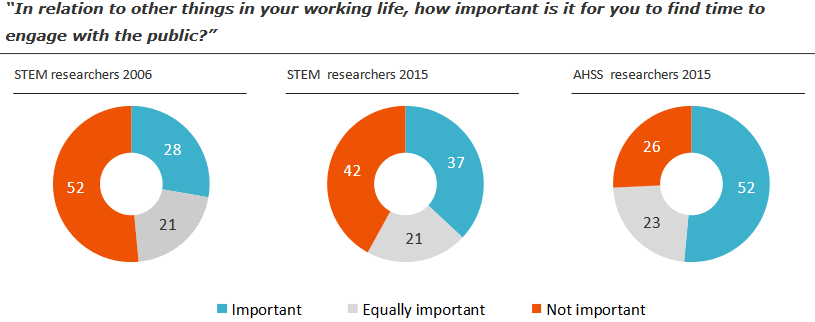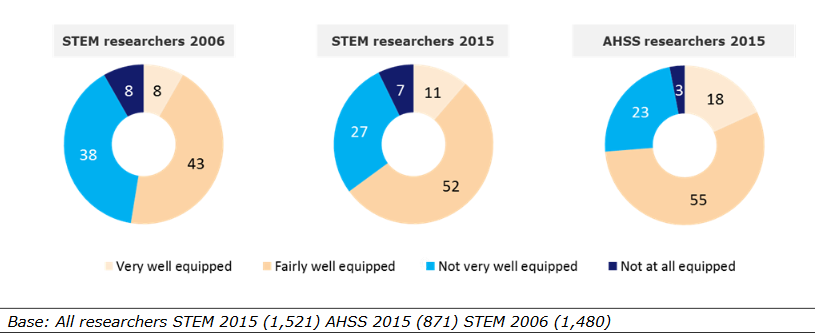Full Citation
TNS-BMRB & PSI. (2015). Factors Affecting Public Engagement by Researchers: A study on behalf of a Consortium of UK public research funders., (December), 1–69. Retrieved from https://wellcome.ac.uk/sites/default/files/wtp060033_0.pdf
Summary
The studies presented in this section investigated dissemination to the public from the researchers’ and public engagement enablers’ point of view. The first, “Factors affecting public engagement by researchers” came out of a project by the UK consortium TNS-BMRB & PSI, and represents an update to an earlier project by the Royal Society in 2006.
The empirical work consisted of a survey of 2,454 researchers and 269 public engagement enablers, as well as 50 qualitative interviews. As the title suggests, the understanding of dissemination is within the second stage of Beaufort’s classification. Interestingly enough, the study also asked respondents as well what public engagement meant to them. 41% of researchers and 59% of enablers gave the answer “Interacting with the public/an audience/two-way dialogue”.
The study reveals that 82% of researchers have engaged in a public engagement activity in a 12-month period, but it also notes that activity is often infrequent. The highest amount of activity can be seen for communication via social media, with 36% of researchers engaging in this activity four or more times, followed by giving a public lecture, which 48% of researchers did at least once. STEM (Science, Technology, Engineering and Mathematics) researchers are less active in engaging in a public activity than AHSS (Arts, Humanities, and Social Sciences) researchers.
Nevertheless, the study authors observed a trend among STEM researchers to assign a higher importance to engagement with the public than in 2006 (see Figure 1). In addition, 53% of STEM researchers and 58% of AHSS researchers would like to spend more time engaging with the public.
Figure 1: Attitudes towards the value of public engagement (2006 & 2015)

Source: TNS-BMRB & PSI (2015), © TNS 2015. Used with permission.
In terms of demographic features, the authors summarize that more senior staff, especially more senior female staff are most active in public engagement. In addition, those who have received training in public engagement and those who consider themselves well equipped in public engagement skills are more active than those who don’t. The same applies to clinicians and respondents with a research and teaching contract.
When it comes to audiences, policy makers and politicians were seen as the most important audience to engage with by researchers (80%), followed by the general public and journalists/TV/radio. For enablers, these groups were of similar importance, along with young people in school and school teachers (84-87%). Industry and business followed not far behind (81%). It should be noted that the study did not question people, whether these were the audiences that they were actually engaging with.
Regarding perceived benefits, “Inform the public/raise awareness” took the top spot (51%), with ensuring that research is relevant (44%), maintaining public support for research (34%) and contributing to public debates (31%). When looking at AHSS researchers alone, the picture looks vastly different: contributing to public debates was mentioned most (54%), whereas maintaining public support for research received 20% and was only the fifth most mentioned benefit. With AHSS researchers, learning from public groups is the fourth most mentioned benefit (33%).
When asked whether researchers felt well equipped to engage with the public, two thirds reported that they were either very equipped (13%) or fairly equipped (53%). For STEM researchers, although feeling slightly less equipped to engage with the public than AHSS researchers, again a positive trend could be observed since 2006 (see Figure 2).
Finally, with regards to the barriers, the most important factor stopping researchers from getting more involved in public engagement were competing pressures on researchers’ time (61%). Lack of opportunities/difficulty finding relevant audiences and not enough funding/difficulties getting funding came in on a joint second place (26%).
Figure 2. How well equipped do you feel to engage with the public on your research or subject? (2006 & 2015)

Source: TNS-BMRB & PSI (2015), © TNS 2015. Used with permission
Access
Gold
Link
https://wellcome.ac.uk/sites/default/files/wtp060033_0.pdf




